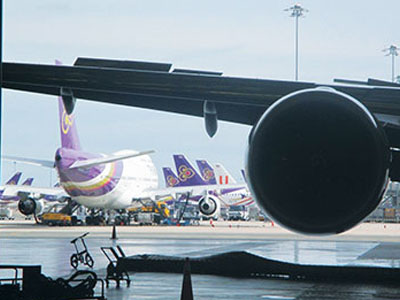
Features
MRO
Alternate Approach: Connecting the dots
By 2020, Asia is expected to account for one of every three new aircraft deliveries.
September 8, 2014 By David Carr
By 2020, Asia is expected to account for one of every three new aircraft deliveries. Thailand, an industrious nation of 67 million, wants in as a supplier to OEMs (original equipment manufacturers) and in MRO (maintenance, repair and overhaul). Some of the dots are already in place, including Michelin, which manufactures aircraft tires in Thailand; Wichita-based Triumph, which produces engine parts, including for the Bombardier Q400; and the U.K.’s Senior plc, whose output includes compressor blades and airfoils for the V2500 commercial engine.
 |
|
| The BOI understands the size and significance of Canada’s aerospace industry and is making the effort to attract business. Photo: David Carr
|
In 2013, exports of aircraft parts and equipment from Thailand topped US$1.7 billion, a year-over-year increase of 87 per cent. While some of the dots may be in place, there is a bigger job ahead connecting them and attracting investment from more companies such as Bombardier and Pratt & Whitney Canada, including building an aviation cluster similar to those in Montreal or neighbouring Singapore.
The country has been down this road before, most notably in the automotive sector. In 30 years, cars, parts and accessories have gone from idle to pole position as the country’s leading export, valued at more than US$25 billion in 2013, with every major car brand present. “There was no national car-making strategy,” Ajarin Pattanapanchai, Deputy Secretary General of the Thailand Board of Investment (BOI), told Wings. “We invited major car makers in and the government played the role of matchmaker.”
Pattanapanchai said the BOI understands the size and significance of Canada’s aerospace industry and is making the effort to attract business. She makes an annual visit to Canada and was in Montreal last October knocking on doors. She insists the interest level is high, “but it is quite new for Canadian aerospace companies to be thinking about Thailand.”
For now there is no strategy to directly target Canada, except to tack toward Tier I and II manufacturing, which appears to be consistent with the government’s approach to building a presence in aerospace overall. And while success in the auto sector may be driving Thailand’s vision for manufacturing and MRO, it is neighbouring Singapore that has drawn the road map.
Singapore has become a global manufacturing hub for aerospace and accounts for approximately 25 per cent of Asia’s MRO activity, according to the London Financial Times. Like Singapore, Thailand offers a favourable tax structure, access to a well-trained and cost-competitive workforce, good infrastructure and business-friendly regulations in key areas such as foreign ownership and intellectual property protection, practices that have not been impacted by a recent military coup. What is missing is a Thai version of Singapore’s Seletar Airport, an abandoned Royal Air Force base that has been converted into a 320-hectare aerospace park, where Rolls Royce is building Trent engines and Pratt & Whitney will begin to manufacture fan blades next year.
“Singapore is far ahead of us in aviation,” said Kamjorn Vorawongsakul, a vice-president with AMATA, a leading industrial estate developer, where several of Thailand’s aerospace firms are located. There are plans to redevelop Korat Airport, an old Royal Thai Air Force base into Thailand’s first aerospace industrial park. Korat has a 2,100-metre runway and is located outside 250 kilometres northeast of Bangkok in Nakhom Ratchasima, Thailand’s second largest city. While the land is government-owned, there is no date yet for when development will begin.
Attracting future Canadian investment will likely require taking a path similar to Michelin, the France-based tire manufacturer. Michelin began producing tires in Thailand in 1987. The company expanded into the aviation sector in 2003 and accounts for one-third of Michelin’s global aviation tire output.
Thailand is confident it is putting the winning conditions in place for a vibrant aerospace industry, including membership in the Association of Southeast Asian Nations, a 3.3 billion person free trading bloc including China, India and Japan. If there is a spanner in the works it would be the instability caused by last May’s coup. Still, lessons have been learned from the last coup, eight years ago. The military recently announced the go ahead of major infrastructure projects, including high-speed rail, and approval of more than US$21 billion in foreign investment, previously stalled because of the uncertainty. “We have passed through many crises and our approach to free markets has not changed. This is a positive thing,” Pattanapanchai said.
David Carr is a Wings writer and columnist.